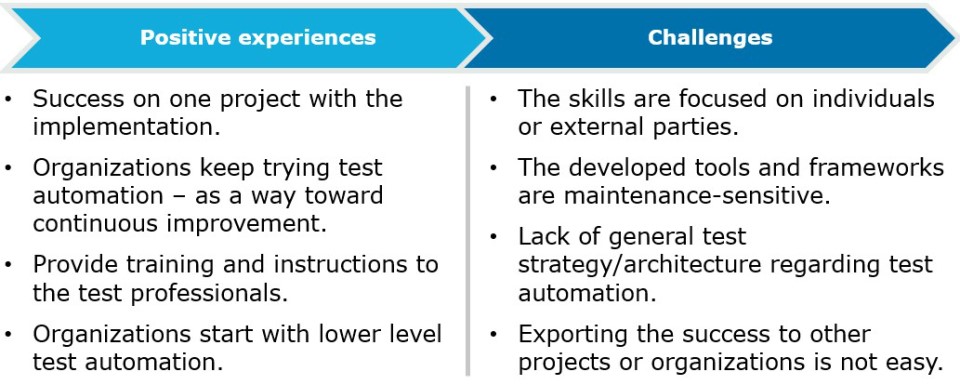BLOG
WE SHARE OUR KNOWLEDGE
Challenges in implementing test automation
Datum: november 30, 2018
We conducted a research about implementing test automation within the organizations. Read this blog to learn about the key findings.
The software has changed dramatically from small programs to complex comprehensive IT systems over the last decade. Our lives are increasingly determined by its presence everywhere – right from our toothbrush to our cars. The quality of the software, therefore, stands to be of crucial importance. Organizations, which rely on manual testing methods, have to deal with an increasing pressure on faster time-to-market cycles. Software testers have to work iteratively to ensure the product continues to work even when there are multiple deliveries, resulting in tremendous pressure on the test process. This is where test automation plays an important role.
We conducted research about implementing test automation within the organizations. Based on this research we see that the organizations start enthusiastically with the implementation of test automation, but as time progresses, the enthusiasm decreases and the organization ceases.
Research approach
We examined 17 different projects regarding the implementation of test automation within test and QA organizations of different companies in the Netherlands. As a research method, we used semi-structured interviews. In this case study, the Test Automation Consultants (TACs) who implement or work with test automation were interviewed. This research focused on the question: “What are the positive experiences and challenges with Test Automation within the different organizations in the long run?” Thus, what has happened with the efforts from the past, and what are the changes the test automation will keep running after that one consultant leaves.
Based on interviews, we had positive experiences but faced challenges regarding test automation. The chart below lists the positive experiences and challenges.

Key results of the research:
- There was only one successful application of test automation, which is not a lot and means that test automation needs work, hard work.
- Test automation is started using a project-based approach in various organizations, where the organization and the test professionals are enthusiastic about automating current tests on different levels from a unit to a Graphical User Interface (GUI). The first projects are started successfully, and the agreed deliverables are delivered. The test professionals who are to work with the delivered tool or framework are trained. After the implementations of the tools, some challenges arise, such as maintenance on test scripts or code. This is due to the fact that not all test professionals have the skills to be able to do the maintenance of the test scripts or code. The organizations, however, keep trying test automation and see it as continuous improvement. In an ideal scenario, all the three wheels (as shown in the figure below) need to turn, to have continuous improvement within the organization.

- Most test professionals hired by an organization are outsourced. Thus, test automation remains dependent on individuals or external parties. Transferring the knowledge to the rest of the organization, therefore, becomes a challenge.
- It was also noticeable that not all organizations have a specific test strategy or architecture when implementing test automation. The organizations focus more on automating test scripts instead of thinking of an overall test strategy or architecture for the organization. This results in using tools that do not align with the other tools within the architecture of the organization. And worse – we start testing the wrong things.
The next practical recommendations are based on this research to help the QA & Testing professionals further with test automation.
- Start with the WHAT. What do you want to test and by whom?
- Identify in this the regressions and routine tasks, which can be automated by using test automation tools.
- Maintenance of your test automation is part of your test architecture.
- Make sure that you are doing enough unit testing to avoid finding defects on higher levels.
- Is there enough knowledge regarding test automation within the organization?
- Use it often in your tests to overcome the maintenance bottlenecks.
The learning points from the past are till valid for many organizations.
We know it is not easy to do test automation, however, it is important to have a closer look at your organization and decide what makes sense.
Ethiek van kunstmatige intelligentie
Datum: juni 6, 2020
Tegenwoordig is Informatie Technologie overal aanwezig. Steeds meer worden onze levens bepaald en beïnvloed hierdoor. In verschillende sectoren zijn deze ontwikkelingen terug te zien. Onze systemen, apparaten, auto’s en toestellen werken op basis van onze input en bij problemen lossen wij mensen die op. Hoe zou het zijn dat onze apparaten zelf nadenken en ook zelf problemen voor ons oplossen? Daar komt Kunstmatige Intelligentie (of Artificiële Intelligentie – AI) om de hoek kijken. Het idee hiervan is dat zij het denkvermogen van de mens nabootsen. Zij zouden dan in staat moeten zijn om zelfstandig beslissingen te nemen op basis van triggers uit de omgeving. De achterliggende gedachte bij AI is dat een apparaat leert om zelfstandig beslissingen te nemen door patronen te herkennen en algoritmes te volgen. Dit betekent dat zij fouten maken en daarvan leren om nog effectiever te worden. Het is een soort van opvoedingsmechanisme. Dit wordt ook wel Machine Learning genoemd. Op Social Media wordt gebruik gemaakt van algoritmes om aanbevelingen te doen voor filmpjes, reclames etc. Het kan enerzijds grote voordelen hebben voor de mensheid, maar anderzijds vormt het echter ook een risico voor de mens. Omdat zij fouten kunnen maken, die fatale gevolgen kunnen hebben in sommige situaties. Daarom zijn de juridische en ethische kaders van AI zeer belangrijk. Het dilemma van AI is in hoeverre wij onze levens laten bepalen en beïnvloeden door AI.



